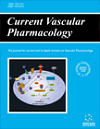-
oa Editorial [Hot Topic: New Concepts of Angiotensin Receptor Blocker (ARB) in Atherosclerosis: ARB as a Metabolic-Improving Agent (Guest Editor: Minako Yamaoka-Tojo)]
- Source: Current Vascular Pharmacology, Volume 9, Issue 2, Mar 2011, p. 128 - 128
-
- 01 Mar 2011
- Previous Article
- Table of Contents
- Next Article
Abstract
A large number of clinical studies proved definitive effects of angiotensin receptor blocker (ARB) on the prevention of both atherosclerosis and cardiac events improving not only hypertension [1] but also metabolic disorders, such as dyslipidemia, diabetes [2, 3], and metabolic syndrome [4]. In addition, ARBs have been reported to have beneficial cardioprotective effects on improving cardiac hypertrophy, diastolic dysfunction, and cardiac remodeling after myocardial infarction like as angiotensin converting enzyme (ACE) inhibitors [5]. Moreover, ARBs are known for their “beyond blood pressure lowering effects” on end-organ protection, such as renal protection in chronic kidney disease [6, 7], reducing new-onset diabetes [8], prevention for ischemic stroke [9-11], and risk reduction in Alzheimer's disease [12]. To clarify the essential roles of ARBs, we need to understand the multifunctional effects of ARB and make the most of their ability. This special issue of Current Vascular Pharmacology is elaborate concerning atheroprotective effects of ARBs focused on the recent findings related to pleiotropic effects of ARBs. Furthermore, known and proposed mechanisms of how ARBs may improve various proatherogenic conditions are discussed, and these effects may be helpful to explain the mechanisms by which ARBs may improve metabolic disorders. The aim of this special issue of CVP is to remind readers of the evidence-based therapeutic possibility of ARBs and of their clinical relevance. Reviews have been written by forefront experts on data obtained from experimental animal models or clinical studies or both. A variety of excited topics are covered including pleiotropic effects of ARBs on: dyslipidemia (Chapter 1), diabetes mellitus (Chapter 2), vascular metabolism (Chapter 3), vascular endothelial progenitor cells (Chapter 4), metabolic syndrome (Chapter 5), and obesity and gastrointestinal hormones (Chapter 6). In this special issue, we hope these reviews will help both basic and clinical researchers to understand recent ARB-related studies and contribute new concepts of ARB to preventive studies for cardiovascular disease in the future. ACKNOWLEDGEMENTS This work was partly supposed by Grants 21790743 (M.Y.-T.) and 21790744 (to T.T.) from the Ministry of Education, Culture, Science and Technology of Japan.


